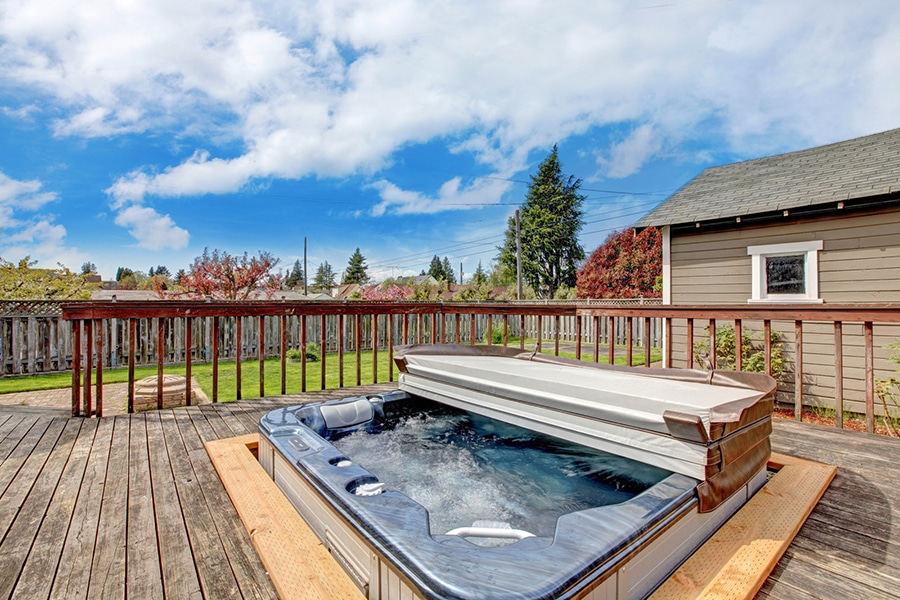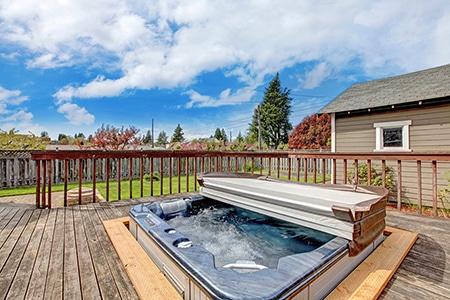
Have you been wondering what sort of base or foundation you need to stand your new hot tub on? I thought I would do some research into the best hot tub bases and here’s what I came up with:
So, what sort of base do I need for a hot tub? A concrete base is ideal, alternatively a terrace or patio, a gravel area or a decking area. Hot tubs are really heavy when full of water so all bases need to be extremely sturdy. It’s also important that the base is completely level to avoid putting a strain on the hot tub and to keep the water level even.
Getting the base right is the key to many happy years of hot tub enjoyment and the right base will help your hot tub to last longer, be more economical and more comfortable to use. The wrong base could lead to expensive damage to your hot tub or property.
Which is the right hot tub base for me?
This will all depend upon your choice of hot tub and where you would like to locate it. You may well already have a patio or terrace area close to the house which would be ideal for your hot tub. Alternatively, you might have a decking area already that would be a great hot tub spot. Perhaps, you might just be starting from scratch and be trying to make the best choice from the outset.
Wherever you choose to put your hot tub remember that it will be extremely heavy when filled with water and will need to be properly supported. A large hot tub can weigh up to 2 Tonnes when filled with water. Add in a full complement of occupants and you can see how the weight starts to stack up! All of this weight is concentrated on a relatively small area so the base needs to be extremely robust.
Similarly, it must be level. Any discrepancy of level will mean that the water isn’t even in the hot tub. This will not only look strange but will also put a great deal of strain on the hot tub body itself which could cause major problems.
You can accurately check how level an area is by using a large spirit level like this one on Amazon.
- Concrete pad. In many ways, you can’t go wrong with a bespoke concrete pad. It will be strong, it will be level and it’s not too hard to DIY if you want to. Ideally, the concrete should be 6 inches thick and reinforced with rebar. It will need to be on a hardcore or rubble base to give a good foundation. Size wise you have two choices: you could have the pad just a little bigger than the hot tub footprint and then build decking or something similar around to walk on, or you could extend the concrete beyond the hot tub to make a solid surround that you could possibly tile.
- Decking. Hot tubs look great on decking and this is a popular option. The main issue is one of weight. Generally speaking, a standard deck will not be designed to take the weight of a hot tub. It’s not just the strength of the deck boards themselves that are the issue but the supporting structure beneath. If in any doubt call in an engineer to advise how to reinforce the deck – it may be that this is possible using reinforced decking materials or it might be that concrete support is needed beneath to be certain.
- Patios/terraces. These can be ideal as long as they are level. You need to also make sure that the foundations are secure. If the patio slabs are just standing on a thin covering of sand or even laid directly on the earth they may well crack and move beneath the weight of the hot tub. A properly laid patio/terrace with proper foundations should be fine.
- Gravel Beds. These can work well assuming that they are laid on solid foundations and that the gravel is level, deep and very well compacted. You will need to create another surface around the bed as gravel is one of the last things you need being carried by feet into the hot tub!
- Hot tub pads. These can be a great solution and are easier to lay than either a gravel bed or concrete pad. You need to dig out a perfectly level surface on the ground and to make sure that the earth is thoroughly compacted. The pads then interlock together and lie in the ground at the size of the hot tub footprint. You then fill the cavities in the pads with gravel or pea shingle, compact again and you will have a solid, level surface. This is a great modern solution and one manufacturer claims that the pads can support up to 420 tonnes per square meter!
Where’s the best location for a home hot tub?
Apart from thinking about the hot tub base there are a few other things to take into consideration as well.
Most people like their hot tub to be relatively close to their home mainly just for the convenience of getting in and out, getting showered, getting dried etc. It’s also nice if the hot tub can be part of the home rather than you having to make a special effort to walk a long way to use it.
Having the hot tub close to the house will probably mean that it is going to be more sheltered from the elements as well. Try to locate the hot tub away from the wind and in a sunny sheltered spot. Screening with fencing or plants can work really well and help to create a really cozy space. If you live somewhere very hot you might want to consider positioning the hot tub in the shade or in a position where it is shady for part of the day. You can always have a sunshade over the hot tub but try to consider your local weather, your preference for sitting in the sun and the time of day when you are most likely to use the hot tub.
It’s always worth considering your neighbors as well. You will probably want to position your hot tub where there is some sense of privacy and also where any noise from the hot tub won’t disturb the people next door.
How do I connect water and electricity to my hot tub?
Hot tubs are usually filled with a garden hose. It’s not particularly glamorous but it does the trick! They generally have a drain to which you can attach a hose as well so that the water can be directed down a drain.
The only other connection they require is electricity. For a permanent hot tub you will need a professional electrician to set up a proper outdoor electrical connection. For an inflatable hot tub it is recommended that you plug the hot tub into a purpose-built outdoor socket. It isn’t advisable to use an extension lead and plug the hot tub into an ordinary indoor socket.
How much does it cost to have a hot tub installed?
Most hot tub suppliers will deliver and install a hot tub as part of the purchase price. Generally speaking, you will need to provide the base as explained above and you will need to hire an electrician to complete the installation.
So, in the simplest case scenario, you may well be able to have the hot tub placed on a solid pre-existing patio, have it delivered for free and just have to pay the electrician – not bad!
However, costs will mount up if you have to create a bespoke base or have landscaping done to accommodate the hot tub. You will also run into problems if the hot tub can’t easily be wheeled to where you want it. If access to your garden is limited you might have to take down fences or even hire a crane to lift the hot tub into position. Not cheap! Ouch!
The key is to plan carefully before the purchase and factor in the cost of the whole project rather than just the cost of the hot tub itself. Failing that buy an inflatable hot tub and your installation costs will be almost non-existent!
Can I move my hot tub once it’s installed?
Yes, of course. Particularly if it is a portable/inflatable hot tub. Fixed or permanent hot tubs can be moved but, depending on the size of the hot tub, you might need professional help. Bear in mind that you will need to rethink the base issue and have the electrical connection broken and reconnected by a professional electrician as well.
Related Questions
How much room do I need for a hot tub? A small hot tub will have a footprint of around 6 feet by 6 feet. You will also need to allow around a foot of clearance around it for maintenance.
How much does a hot tub cost to run per month? Hot tubs are designed to run continuously and will generally use between $40 and $50 per month in electricity. This will depend on the quality of the hot tub’s insulation, the temperature of the water and the ambient temperature.

